Trajectory Optimization of High-Speed Robotic Positioning with Suppressed Motion Jerk via Improved Chicken Swarm Algorithm
Abstract
:1. Introduction
2. Improved Chicken Swarm Algorithm
2.1. Improved CSO
2.1.1. Parallel Policy-Based X-Best Bootstrap and Levy Flight Rooster Update Mechanism
2.1.2. Dynamic Constrained Hen-Following Goal Mechanism
- (1)
- The total number of roosters is constant, and the number of roosters followed by hens as they transition from following all roosters to following high-quality roosters drops;
- (2)
- In the early iterations, the number of followed roosters should be quickly reduced to determine the approximate range of the optimal solution;
- (3)
- In the late iterations, the variation is kept constant or reduced to achieve a precise search and improve the accuracy of the solution;
- (4)
- There is always a worst rooster among good roosters, which improves the diversity of solutions and helps to avoid falling into local optima.
2.2. Implementation Steps of the Algorithm
| Algorithm 1: Pseudocode for the PDCSO algorithm. |
| Initialize a population of N chickens and define the related parameters; Evaluate the chickens’ fitness values, While If Rank the chickens’ fitness values and establish a hierarchal order in the swarm Divide the swarm into different groups and determine the relationship between the chicks and mother hens in a group End For If Select rooster update method using Equation (13) Update its solution/location using Equation (7) or Equation (9) End If Update its solution/location using Equation (15) End If Update its solution/location using Equation (6) End Evaluate the new solution If the new solution is better than the previous one, update it End End |
2.3. Improved Algorithm Performance Testing
3. Construction of the Optimization Objective Function
3.1. Description of Optimal Time-Shock Planning Problem
3.2. B-Spline Interpolation Trajectory Construction
4. Simulation and Experimentation
4.1. ADAMS Simulation
4.2. Experiment
5. Conclusions
Author Contributions
Funding
Institutional Review Board Statement
Informed Consent Statement
Data Availability Statement
Conflicts of Interest
References
- Abu-Dakka, F.J.; Rubio, F.; Valero, F.; Mata, V. Evolutionary indirect approach to solving trayectory planning problem for industrial robots. Eur. J. Mech. 2013, 42, 210–218. [Google Scholar] [CrossRef]
- Cui, L.; Wang, H.; Chen, W. Trajectory planning of a spatial flexible manipulator for vibration suppression. Robot. Auton. Syst. 2019, 123, 103316. [Google Scholar] [CrossRef]
- Tang, L.; Gosselin, C.; Tang, X.; Jiang, X. Dynamic trajectory planning of planar two-dof redundantly actuated cable-suspended parallel robots. In Proceedings of the 2014 IEEE/RSJ International Conference on Intelligent Robots and Systems, Chicago, IL, USA, 14–18 September 2014. [Google Scholar]
- Wang, Y.L.; Yuan, R.B.; Yuan, A.H. Application of differential particle swarm algorithm in inverse kinematics solution of puma robot. Softw. Guide 2020, 19, 203–207. [Google Scholar] [CrossRef]
- Li, L.; Shang, J.Y.; Feng, Y.L.; Huai, Y.W. A review of research on trajectory planning of articulated industrial robots. Comput. Eng. Appl. 2018, 54, 36–50. [Google Scholar] [CrossRef]
- Peng, X.; Chen, G.; Tang, Y.; Miao, C.; Li, Y. Trajectory optimization of an electro-hydraulic robot. J. Mech. Sci. Technol. 2020, 34, 4281–4294. [Google Scholar] [CrossRef]
- Huang, J.; Hu, P.; Wu, K.; Zeng, M. Optimal time-jerk trajectory planning for industrial robots. Mech. Mach. Theory 2018, 121, 530–544. [Google Scholar] [CrossRef]
- Zhang, Y.; Sun, Z.; Sun, Q.; Wang, Y.; Yang, J. Time-jerk optimal trajectory planning of hydraulic robotic excavator. Adv. Mech. Eng. 2021, 13, 1014. [Google Scholar] [CrossRef]
- Du, Y.; Chen, Y. Time Optimal Trajectory Planning Algorithm for Robotic Manipulator Based on Locally Chaotic Particle Swarm Optimization. Chin. J. Electron. 2022, 31, 906–914. [Google Scholar]
- Choi, Y.; Kim, D.; Hwang, S.; Kim, H.; Kim, N.; Han, C. Dual-arm robot motion planning for collision avoidance using B-spline curve. Int. J. Precis. Eng. Manuf. 2017, 18, 835–843. [Google Scholar] [CrossRef]
- Long, Z.; Li, X.T.; Shuai, T.; Wen, F.J.; Feng, W.R.; Liang, C.P. A review of the current status of industrial robot trajectory planning research. Mech. Sci. Technol. 2021, 40, 853–862. [Google Scholar] [CrossRef]
- Meng, X.B.; Gao, X.Z.; Lu, L.; Liu, Y.; Zhang, H. A new bio-inspired optimisation algorithm: Bird Swarm Algorithm. J. Exp. Theor. Artif. Intell. 2015, 28, 673–687. [Google Scholar] [CrossRef]
- Deb, S.; Gao, X.Z.; Tammi, K.; Kalita, K.; Mahanta, P. Recent Studies on Chicken Swarm Optimization algorithm: A review (2014–2018). Artif. Intell. Rev. 2020, 53, 1737–1765. [Google Scholar] [CrossRef]
- Irsalinda, N.; Thobirin, A.; Wijayanti, D.E. Chicken Swarm as a Multi Step Algorithm for Global Optimization. Int. J. Eng. Sci. Invent. 2017, 6, 8–14. [Google Scholar]
- Zhang, M.X.; Zhang, D.M.; Yang, J.Q.; Zhu, C. An improved chicken swarm algorithm based on forward learning and backward learning. Microelectron. Comput. 2018, 35, 6. [Google Scholar]
- Zhang, K.W.; Zhao, X.L.; He, L.; Li, Z.Z. A chicken swarm algorithm with improved x-best guided individuals and dynamic rank update mechanism. J. Beijing Univ. Aeronaut. Astronaut. 2021, 47, 15. [Google Scholar]
- Haiyan, L.U.; Xiang, L.; Shen, W.; Yanchun, G.U. Adaptive Simplified Chicken Swarm Optimization Based on Inverted S-Shaped Inertia Weight. Chin. J. Electron. 2022, 31, 367–386. [Google Scholar]
- Liang, X.; Kou, D.; Wen, L. An improved chicken swarm optimization algorithm and its application in robot path planning. IEEE Access 2022, 8, 49543–49550. [Google Scholar] [CrossRef]
- Huang, X.; Ye, C.M.; Zheng, J. Hybrid improved search strategy for chicken swarm optimization algorithm. Comput. Eng. Appl. 2018, 54, 176–181. [Google Scholar] [CrossRef]
- Kamaruzaman, A.F.; Zain, A.M.; Yusuf, S.M.; Udin, A. Levy Flight Algorithm for Optimization Problems - A Literature Review. Appl. Mech. Mater. 2013, 421, 496–501. [Google Scholar] [CrossRef]
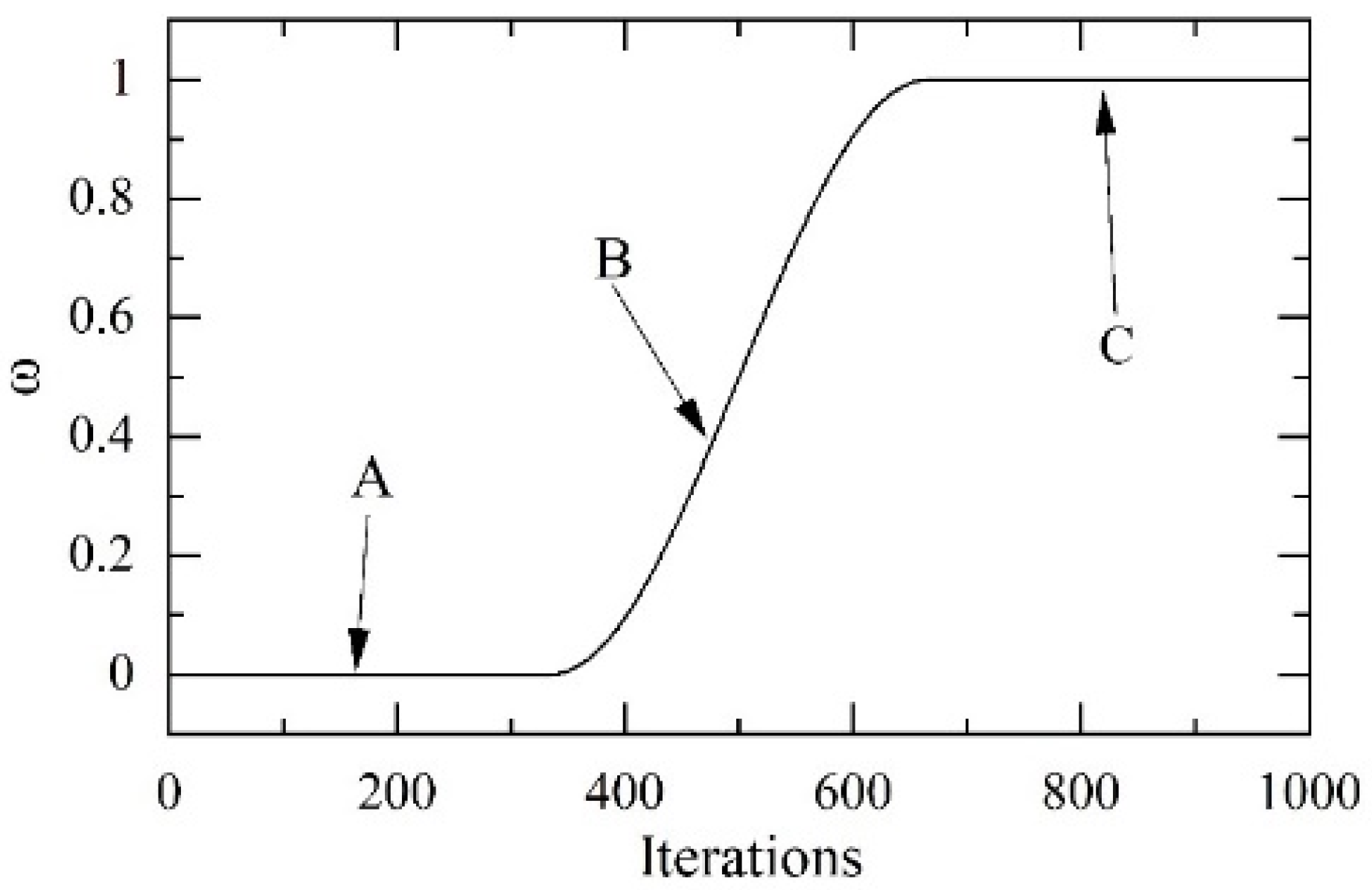


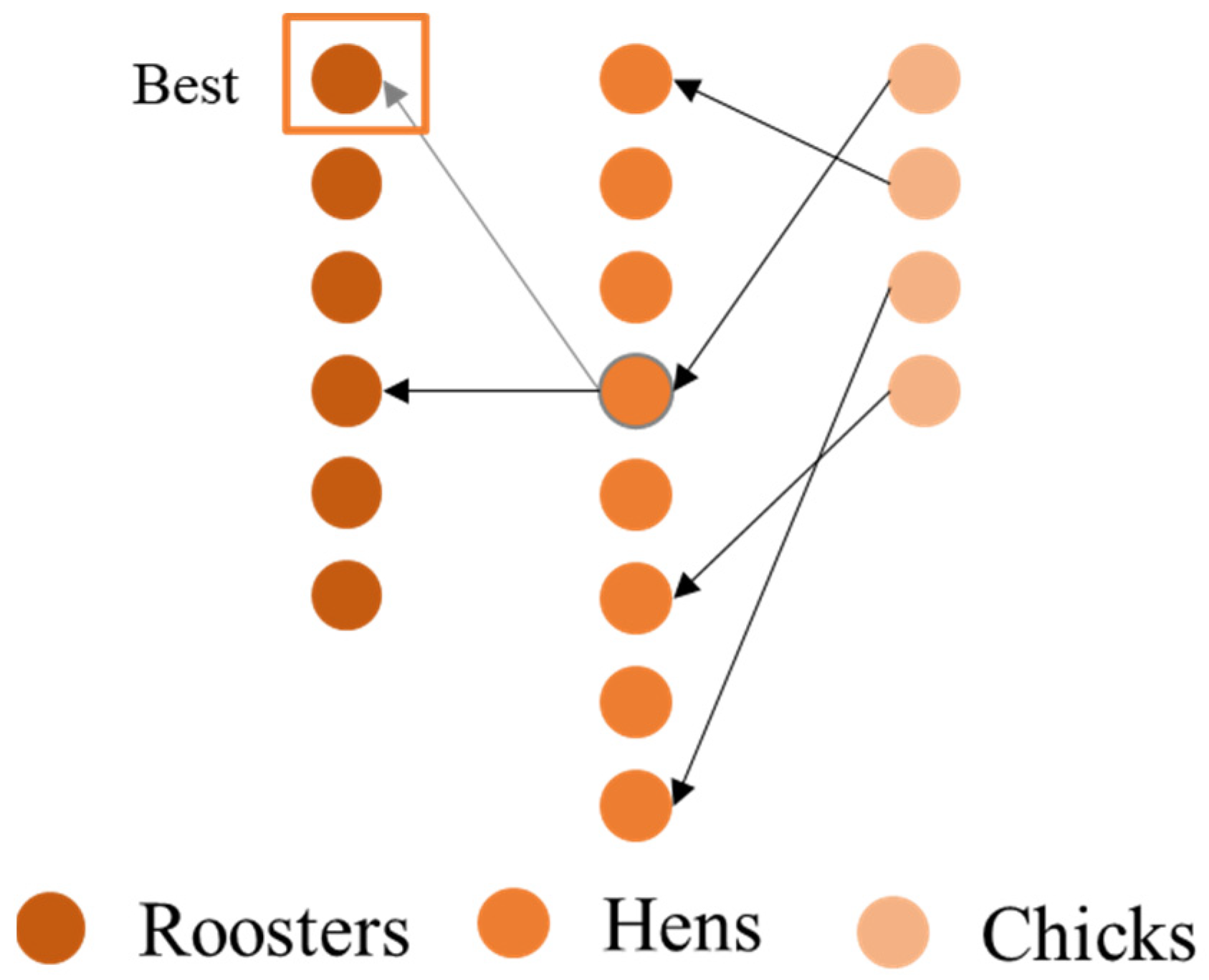
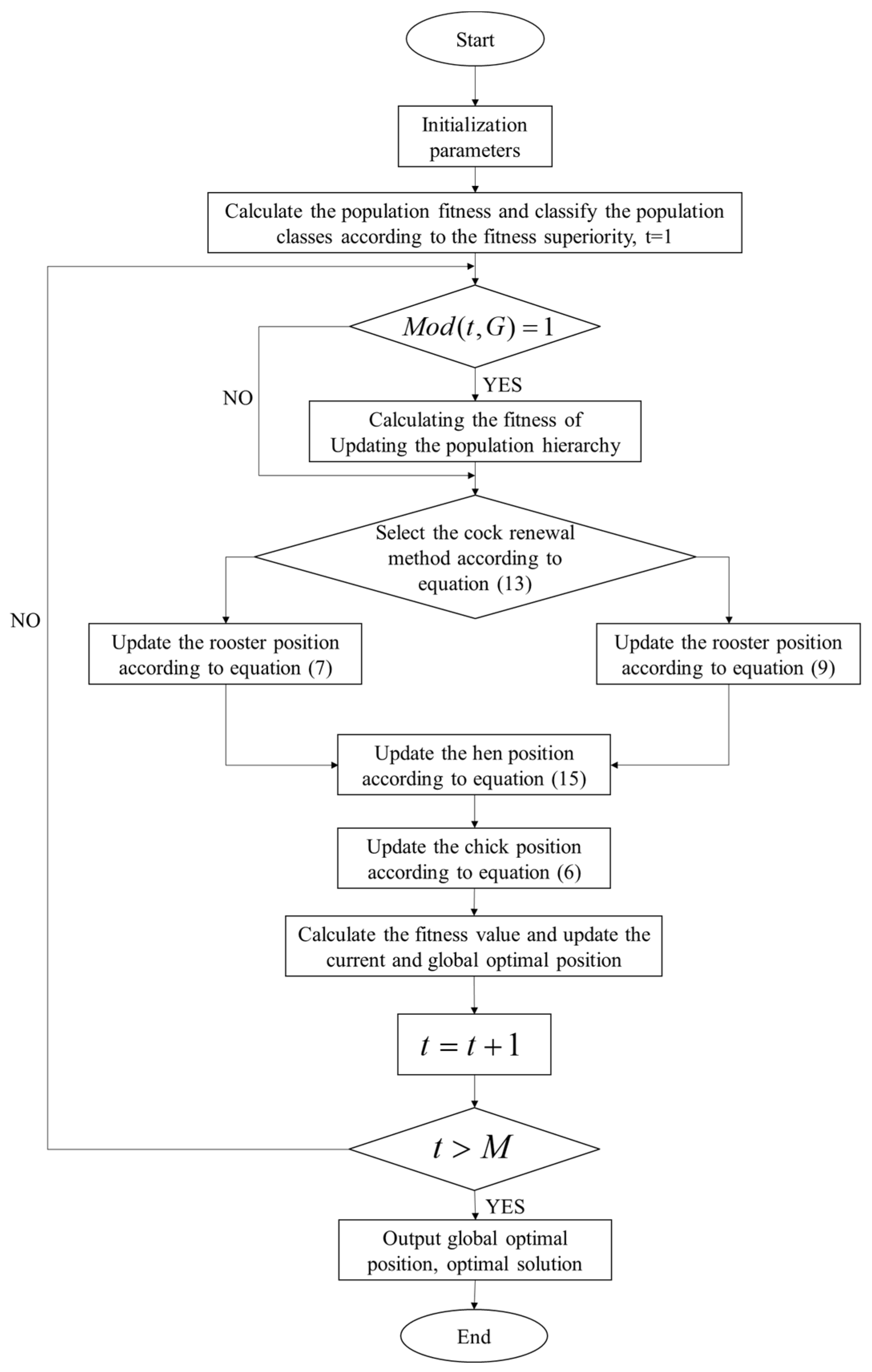
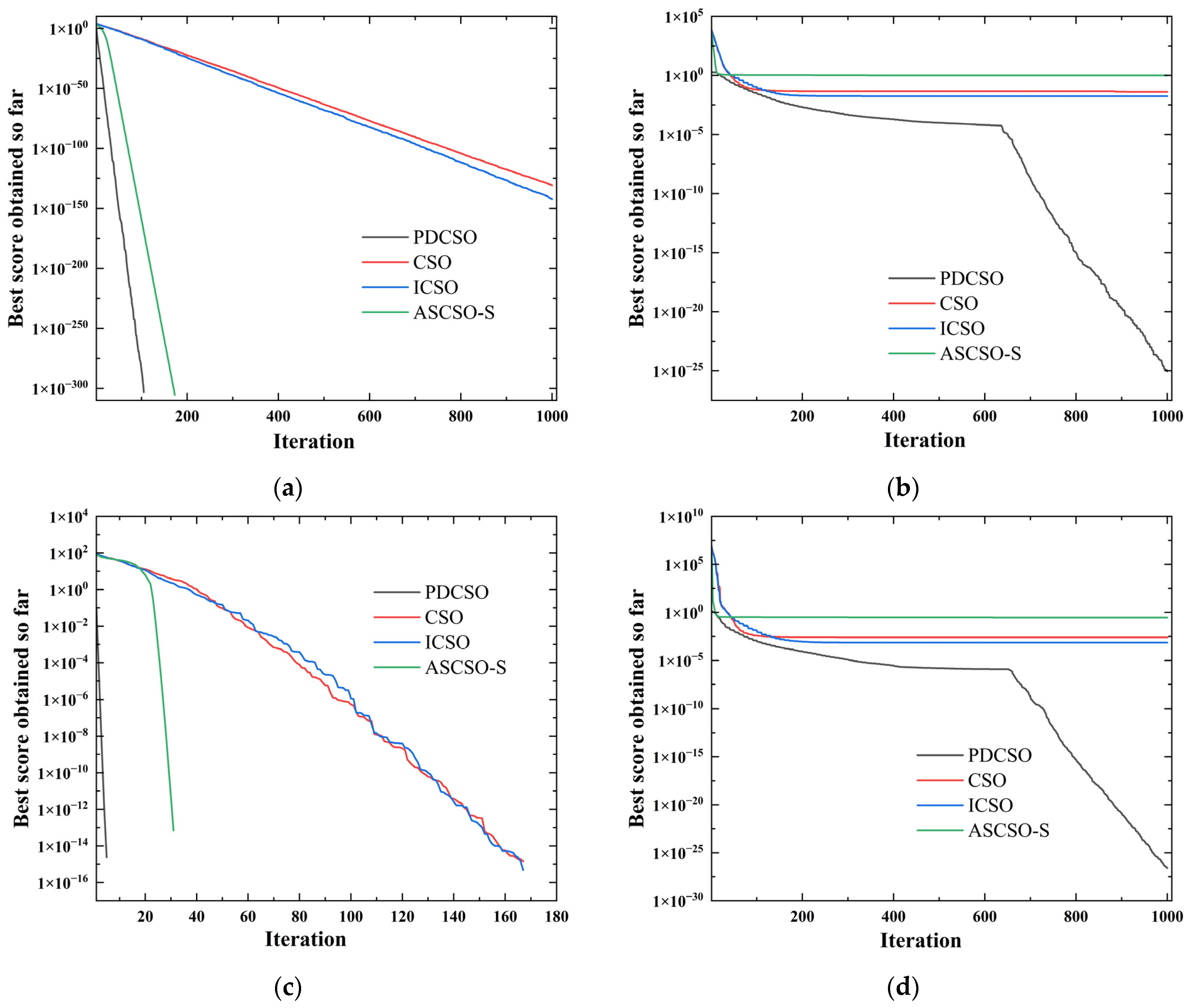



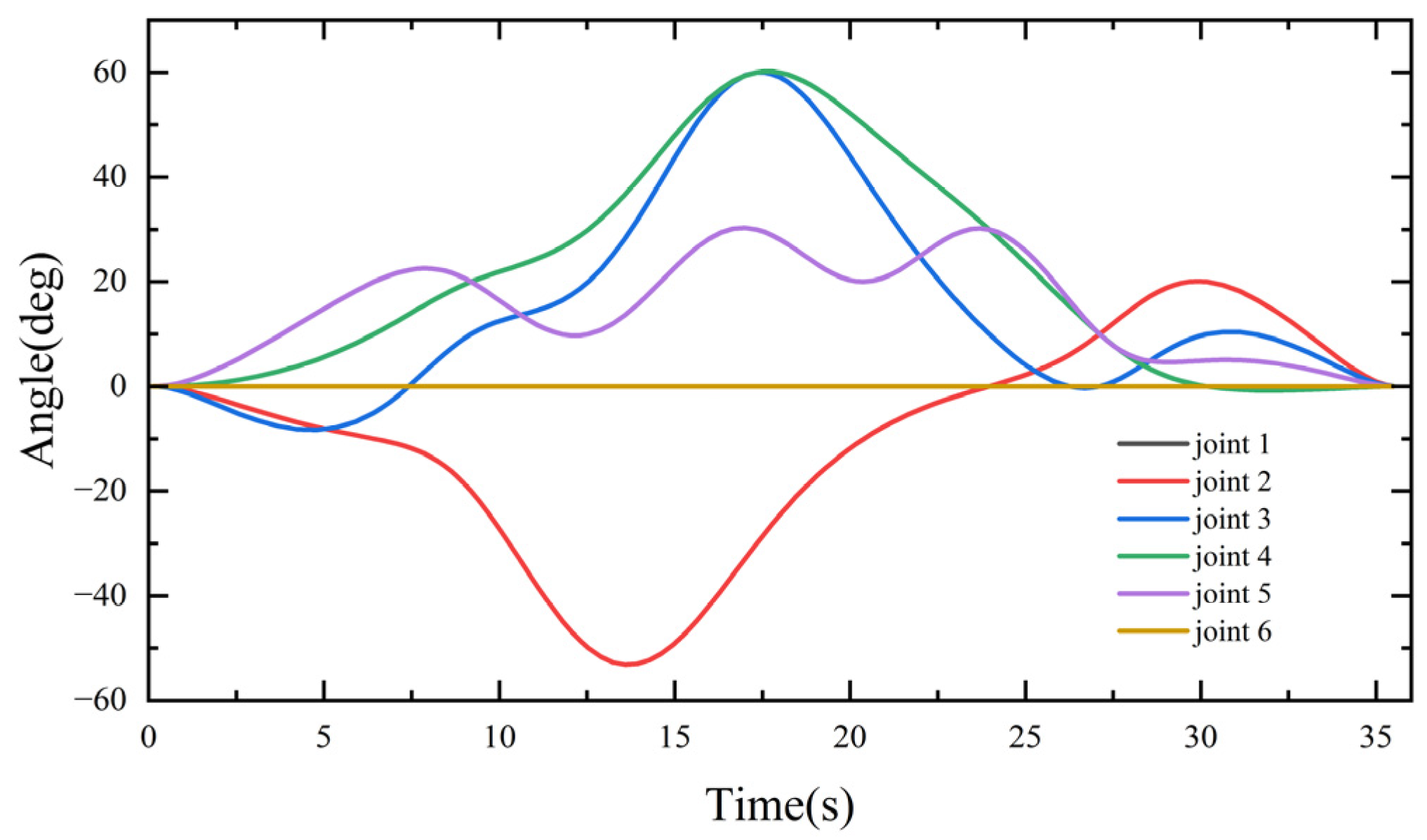





| Function | Range | Dimension | Theoretically Optimal Value |
|---|---|---|---|
| [−100, 100] | D | 0 | |
| [−10, 10] | D | 0 | |
| [−100, 100] | D | 0 | |
| [−100, 100] | D | 0 | |
| [−100, 100] | D | 0 | |
| [−1.28, 1.28] | D | 0 | |
| [−5.12, 5.12] | D | 0 | |
| [−32, 32] | D | 0 | |
| [−600, 600] | D | 0 | |
| [−50, 50] | D | 0 | |
| [−4, 5] | D | 0 | |
| [−5, 10] | D | 0 | |
| [−5, 5] | 4 | 0.0003075 | |
| [(−5, 0), (10, 15)] | 2 | 0.398 | |
| [−2, 2] | 2 | 3 | |
| [−10, 10] | 2 | 0 | |
| [0, ] | 10 | −9.66015 | |
| [−512, 512] | 2 | −959.6407 |
| Algorithm | Parameter Settings |
|---|---|
| CSO | |
| PDCSO | |
| ICSO | |
| ASCSO-S |
| Function | CSO | PDCSO | ICSO | ASCSO-S | |||||
|---|---|---|---|---|---|---|---|---|---|
| F1 | Ave | 0 | 0 | 2 × 10−131 | 1.04 × 10−31 | 2.1 × 10−142 | 1.86 × 10−45 | 0 | 0 |
| Std | 0 | 0 | 9.5 × 10−131 | 4.53 × 10−31 | 8.6 × 10−142 | 7.68 × 10−45 | 0 | 0 | |
| Best | 0 | 0 | 6.2 × 10−136 | 3.79 × 10−50 | 7.5 × 10−151 | 7.47 × 10−50 | 0 | 0 | |
| Worst | 0 | 0 | 5.2 × 10−130 | 2.47 × 10−30 | 4.6 × 10−141 | 4.22 × 10−44 | 0 | 0 | |
| F2 | Ave | 0 | 0 | 7.57 × 10−78 | 4.88 × 10−35 | 2.41 × 10−91 | 4.89 × 10−38 | 0 | 0 |
| Std | 0 | 0 | 3.23 × 10−77 | 1.72 × 10−34 | 1.27 × 10−90 | 8.78 × 10−38 | 0 | 0 | |
| Best | 0 | 0 | 2.58 × 10−80 | 6.16 × 10−40 | 4.03 × 10−96 | 1.96 × 10−40 | 0 | 0 | |
| Worst | 0 | 0 | 1.78 × 10−76 | 9.37 × 10−34 | 6.94 × 10−90 | 4.05 × 10−37 | 0 | 0 | |
| F3 | Ave | 0 | 0 | 1.59 × 10−46 | 149.2781 | 4.75 × 10−70 | 19.57705 | 0 | 0 |
| Std | 0 | 0 | 8.66 × 10−46 | 457.8035 | 1.38 × 10−69 | 98.51109 | 0 | 0 | |
| Best | 0 | 0 | 1.27 × 10−71 | 1.29 × 10−6 | 7.13 × 10−81 | 1.93 × 10−8 | 0 | 0 | |
| Worst | 0 | 0 | 4.74 × 10−45 | 2038.464 | 6.39 × 10−69 | 539.5373 | 0 | 0 | |
| F4 | Ave | 0 | 0 | 4.14 × 10−47 | 18.97023 | 1.21 × 10−59 | 17.23904 | 0 | 0 |
| Std | 0 | 0 | 2.21 × 10−46 | 6.744785 | 2.52 × 10−59 | 6.530568 | 0 | 0 | |
| Best | 0 | 0 | 2.03 × 10−52 | 1.201056 | 2.89 × 10−68 | 0.125546 | 0 | 0 | |
| Worst | 0 | 0 | 1.21 × 10−45 | 28.29731 | 8.94 × 10−59 | 25.15158 | 0 | 0 | |
| F5 | Ave | 1.13 × 10−26 | 0.073115 | 0.043912 | 4.416301 | 0.019847 | 5.616788 | 0.966116 | 10.02114 |
| Std | 2.58 × 10−26 | 0.09572 | 0.031135 | 0.376249 | 0.048784 | 0.338539 | 0.152327 | 0.330825 | |
| Best | 9.21 × 10−31 | 0.00795 | 0.001415 | 3.844698 | 0.000216 | 5.041785 | 0.655284 | 8.975014 | |
| Worst | 1.18 × 10−25 | 0.282306 | 0.124232 | 5.418371 | 0.270026 | 6.263295 | 1.259867 | 10.49705 | |
| F6 | Ave | 5.64 × 10−5 | 6.44 × 10−5 | 0.000227 | 0.001258 | 0.000344 | 0.001001 | 7.63 × 10−5 | 0.000118 |
| Std | 5.37 × 10−5 | 6.66 × 10−5 | 0.000133 | 0.000405 | 0.000222 | 0.000536 | 7.68 × 10−5 | 0.000112 | |
| Best | 9.17 × 10−7 | 2.49 × 10−6 | 3.51 × 10−5 | 0.000596 | 1.9 × 10−5 | 0.000415 | 2.75 × 10−6 | 4.85 × 10−6 | |
| Worst | 0.000262 | 0.000263 | 0.000475 | 0.002215 | 0.000832 | 0.003155 | 0.000332 | 0.00047 | |
| F7 | Ave | 0 | 0 | 0 | 0 | 0 | 0 | 0 | 0 |
| Std | 0 | 0 | 0 | 0 | 0 | 0 | 0 | 0 | |
| Best | 0 | 0 | 0 | 0 | 0 | 0 | 0 | 0 | |
| Worst | 0 | 0 | 0 | 0 | 0 | 0 | 0 | 0 | |
| F8 | Ave | 8.88 × 10−16 | 8.88 × 10−16 | 1.6 × 10−15 | 1.14 × 10−14 | 8.88 × 10−16 | 4.20 × 10−15 | 8.88 × 10−16 | 8.88 × 10−16 |
| Std | 0 | 0 | 1.45 × 10−15 | 2.90 × 10−14 | 0 | 9.01 × 10−16 | 0 | 0 | |
| Best | 8.88 × 10−16 | 8.88 × 10−16 | 8.88 × 10−16 | 4.44 × 10−15 | 8.88 × 10−16 | 8.88 × 10−16 | 8.88 × 10−16 | 8.88 × 10−16 | |
| Worst | 8.88 × 10−16 | 8.88 × 10−16 | 4.44 × 10−15 | 1.64 × 10−13 | 8.88 × 10−16 | 4.44 × 10−15 | 8.88 × 10−16 | 8.88 × 10−16 | |
| F9 | Ave | 0 | 0 | 0 | 0 | 0 | 0 | 0 | 0 |
| Std | 0 | 0 | 0 | 0 | 0 | 0 | 0 | 0 | |
| Best | 0 | 0 | 0 | 0 | 0 | 0 | 0 | 0 | |
| Worst | 0 | 0 | 0 | 0 | 0 | 0 | 0 | 0 | |
| F10 | Ave | 1.84 × 10−27 | 0.000681 | 0.002161 | 0.216774 | 0.001866 | 0.329059 | 0.317632 | 0.855516 |
| Std | 5.35 × 10−27 | 0.001182 | 0.001818 | 0.04494 | 0.002993 | 0.035752 | 0.096942 | 0.040541 | |
| Best | 4.74 × 10−32 | 5.48 × 10−5 | 1.29 × 10−5 | 0.15463 | 7.2 × 10−7 | 0.233194 | 0.107997 | 0.743935 | |
| Worst | 2.69 × 10−26 | 0.004427 | 0.007248 | 0.344528 | 0.012607 | 0.389021 | 0.49548 | 0.924134 | |
| F11 | Ave | 0 | 0 | 1.07 × 10−6 | 6.97 × 10−7 | 3.05 × 10−9 | 1.82 × 10−30 | 0 | 0 |
| Std | 0 | 0 | 5.85 × 10−6 | 1.67 × 10−6 | 1.66 × 10−8 | 7.41 × 10−30 | 0 | 0 | |
| Best | 0 | 0 | 3.5 × 10−42 | 9.37 × 10−36 | 3.18 × 10−71 | 1.54 × 10−48 | 0 | 0 | |
| Worst | 0 | 0 | 3.2 × 10−5 | 5.83 × 10−6 | 9.12 × 10−8 | 3.99 × 10−29 | 0 | 0 | |
| F12 | Ave | 0 | 0 | 1.02 × 10−57 | 3.239553 | 4.47 × 10−65 | 3.550345 | 0 | 0 |
| Std | 0 | 0 | 2.49 × 10−57 | 2.054349 | 2.43 × 10−64 | 1.95467 | 0 | 0 | |
| Best | 0 | 0 | 2.78 × 10−62 | 0.525498 | 3.44 × 10−78 | 1.092479 | 0 | 0 | |
| Worst | 0 | 0 | 9.85 × 10−57 | 8.636726 | 1.33 × 10−63 | 9.225863 | 0 | 0 | |
| F13 | Ave | 0.000338 | 0.00062 | 0.000593 | 0.001151 | ||||
| Std | 0.000167 | 0.000187 | 0.000205 | 0.000363 | |||||
| Best | 0.000307 | 0.000308 | 0.000307 | 0.000521 | |||||
| Worst | 0.001223 | 0.001223 | 0.001223 | 0.002194 | |||||
| F14 | Ave | 0.397887 | 0.397887 | 0.397887 | 0.414706 | ||||
| Std | 0 | 2.52 × 10−9 | 1 × 10−10 | 0.01935 | |||||
| Best | 0.397887 | 0.397887 | 0.397887 | 0.398084 | |||||
| Worst | 0.397887 | 0.397887 | 0.397887 | 0.47301 | |||||
| F15 | Ave | 3 | 3 | 3 | 3.229174 | ||||
| Std | 1.32 × 10−15 | 1.34 × 10−15 | 8.29 × 10−8 | 0.332011 | |||||
| Best | 3 | 3 | 3 | 3.001369 | |||||
| Worst | 3 | 3 | 3 | 4.782669 | |||||
| F16 | Ave | 0 | 0 | 0 | 0.02634 | ||||
| Std | 0 | 0 | 0 | 0.025041 | |||||
| Best | 0 | 0 | 0 | 0.001075 | |||||
| Worst | 0 | 0 | 0 | 0.122481 | |||||
| F17 | Ave | −9.3287 | −9.22455 | −9.16256 | −3.67902 | ||||
| Std | 0.174558 | 0.279614 | 0.256986 | 0.42561 | |||||
| Best | −9.65524 | −9.61852 | −9.60838 | −4.55678 | |||||
| Worst | −9.00491 | −8.2349 | −8.58308 | −2.91759 | |||||
| F18 | Ave | −959.641 | −959.641 | −959.641 | −909.584 | ||||
| Std | 5.78 × 10−13 | 5.78 × 10−13 | 1.63 × 10−6 | 45.37918 | |||||
| Best | −959.641 | −959.641 | −959.641 | −959.641 | |||||
| Worst | −959.641 | −959.641 | −959.641 | −820.583 | |||||
| Linkage Number | |||||
|---|---|---|---|---|---|
| 1 | 0 | 162.5 | −363–363 | ||
| 2 | 0 | −425 | 0 | −363–363 | |
| 3 | 0 | 392.2 | 0 | −363–363 | |
| 4 | 0 | 133.3 | −363–363 | ||
| 5 | 0 | 99.7 | −363–363 | ||
| 6 | 0 | 0 | 99.3 | −363–363 |
| Nodes | ||||||
|---|---|---|---|---|---|---|
| Joint 1 | Joint 2 | Joint 3 | Joint 4 | Joint 5 | Joint 6 | |
| 1 | 0 | 0 | 0 | 0 | 0 | 0 |
| 2 | 0 | −10 | −5 | 10 | 20 | 0 |
| 3 | 0 | −20 | 10 | 20 | 20 | 0 |
| 4 | 0 | −50 | 20 | 30 | 10 | 0 |
| 5 | 0 | −30 | 60 | 60 | 30 | 0 |
| 6 | 0 | −10 | 40 | 50 | 20 | 0 |
| 7 | 0 | 0 | 10 | 30 | 30 | 0 |
| 8 | 0 | 10 | 0 | 10 | 10 | 0 |
| 9 | 0 | 20 | 10 | 0 | 5 | 0 |
| 10 | 0 | 0 | 0 | 0 | 0 | 0 |
Disclaimer/Publisher’s Note: The statements, opinions and data contained in all publications are solely those of the individual author(s) and contributor(s) and not of MDPI and/or the editor(s). MDPI and/or the editor(s) disclaim responsibility for any injury to people or property resulting from any ideas, methods, instructions or products referred to in the content. |
© 2023 by the authors. Licensee MDPI, Basel, Switzerland. This article is an open access article distributed under the terms and conditions of the Creative Commons Attribution (CC BY) license (https://creativecommons.org/licenses/by/4.0/).
Share and Cite
Li, Y.; Lu, Y.; Li, D.; Zhou, M.; Xu, C.; Gao, X.; Liu, Y. Trajectory Optimization of High-Speed Robotic Positioning with Suppressed Motion Jerk via Improved Chicken Swarm Algorithm. Appl. Sci. 2023, 13, 4439. https://doi.org/10.3390/app13074439
Li Y, Lu Y, Li D, Zhou M, Xu C, Gao X, Liu Y. Trajectory Optimization of High-Speed Robotic Positioning with Suppressed Motion Jerk via Improved Chicken Swarm Algorithm. Applied Sciences. 2023; 13(7):4439. https://doi.org/10.3390/app13074439
Chicago/Turabian StyleLi, Yankun, Yuyang Lu, Dongya Li, Minning Zhou, Chonghai Xu, Xiaozhi Gao, and Yu Liu. 2023. "Trajectory Optimization of High-Speed Robotic Positioning with Suppressed Motion Jerk via Improved Chicken Swarm Algorithm" Applied Sciences 13, no. 7: 4439. https://doi.org/10.3390/app13074439
APA StyleLi, Y., Lu, Y., Li, D., Zhou, M., Xu, C., Gao, X., & Liu, Y. (2023). Trajectory Optimization of High-Speed Robotic Positioning with Suppressed Motion Jerk via Improved Chicken Swarm Algorithm. Applied Sciences, 13(7), 4439. https://doi.org/10.3390/app13074439







